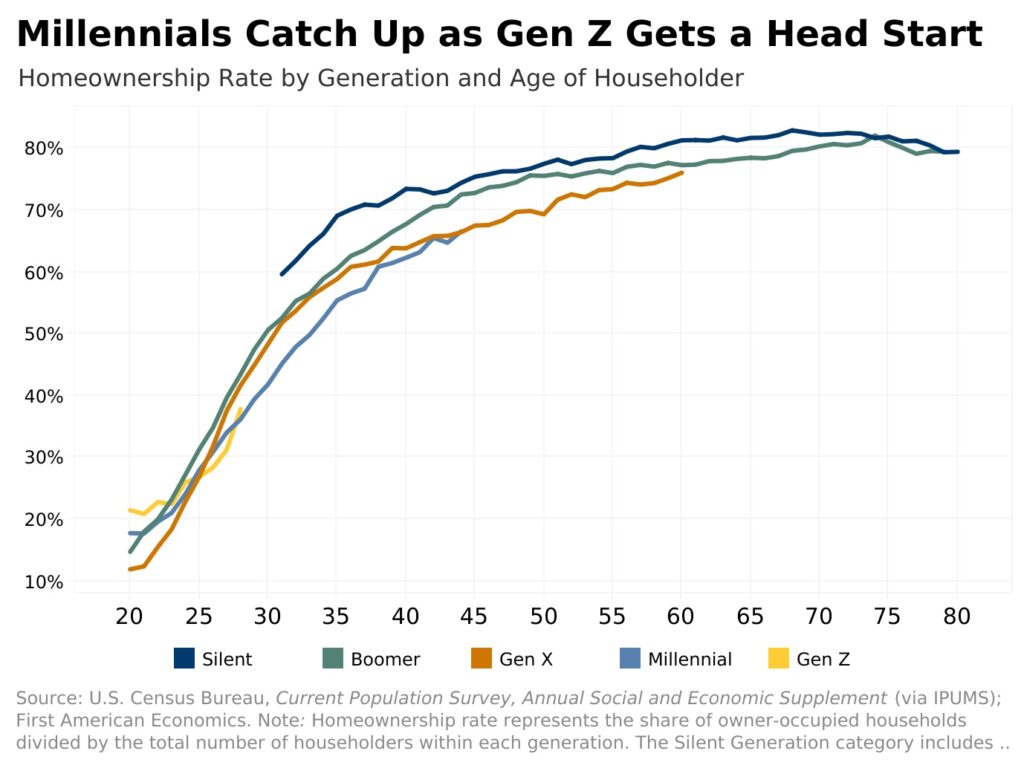Even though everyone comes at various times, homeownership unites generations, according to new data from First American. In light of this, experts looked at the generational composition of this year’s homeownership table and how the seating chart is changing using the most recent 2025 Current Population Survey microdata. It was discovered that the housing market is changing, with younger generations quickly gaining seats while elderly homeowners continue to hold the majority of them.
Home purchases are rarely made in a vacuum. Usually, life’s pivotal events—marriage, having children, changing careers, or just the need for additional space—are what cause it. When aspiration turns into action is determined by economic factors like supply, affordability, and mortgage rates, but life itself is nearly always the initial spark.
“…Millennials and Gen Z remind us that, while the journey to homeownership may lengthen, the destination remains the same.”
In their late 20s or early 30s, Boomers and Gen Xers frequently bought homes since they were married, had children, and established careers earlier in life. In contrast, millennials and Gen Z have spent more time in school and developing their jobs. They also confront substantial financial challenges and a limited supply of property, which has caused them to postpone marriage, kids, and, consequently, their first home purchase.
Approximately half of Gen Xers and Boomers owned a home by the age of thirty. Gen Z seems to be following the same path as Millennials, who didn’t reach that milestone until they were 33.
Millennials, the largest and most educated generation in U.S. history and once branded “forever renters,” are rapidly buying homes in their thirties and reaching parity with Gen X by their early forties, proving the dream of homeownership wasn’t dashed, just delayed.

Due to pay increases, flexible remote work schedules, and cheap borrowing prices during the epidemic, Gen Z—the newest generation at the homeownership table—was able to purchase homes earlier than earlier generations. By the age of 28, Gen Z is 1.7 percentage points ahead of millennials, and their early-20s ownership rate surpasses that of previous cohorts. This early strength indicates that their ownership curve may be on par with, or possibly surpass, that of millennials in their early 30s for a generation still in their 20s.
Not to be overlooked, Gen X, the “middle child” of the housing market, is also hitting new benchmarks. The gap between Gen Xers and Boomers, who began in their 40s and 50s during the Great Financial Crisis, is closing as the oldest Gen Xers reach their 60s. They are only behind by 1.7 percentage points, and the gap becomes less every year.
Boomers, whose ownership rates stay high well into their 70s, may provide millennials and Gen Z with one last generational boost. Aging in place has reduced turnover, but as more Boomers reach their 80s, senior-living transitions and life-stage movements will progressively bring back well-located homes to the market, providing a demographic supply tailwind that could hasten the path to homeownership for younger purchasers.
Homeownership has long stood for more than just real estate; it also symbolizes family, relationships, and life-changing events. Millennials and Gen Z remind us that although the path to homeownership may take longer, the final destination is still the same, even though Boomers and Gen X may have become homeowners earlier. As Gen Z completes its 20s and millennials enter their late 30s and early 40s, the forecast provides a strong foundation for younger generations to catch up, with affordability increasing, inventory loosening, and buyer activity gradually gaining speed into 2026.
To read more, click here.






